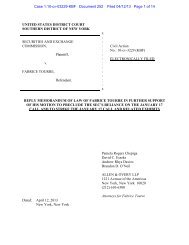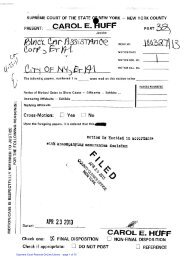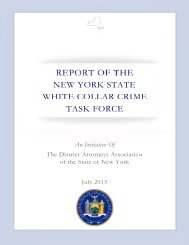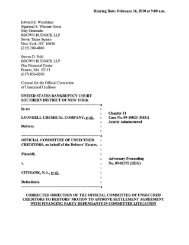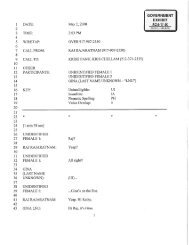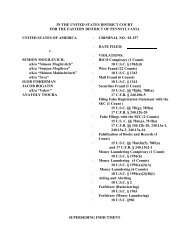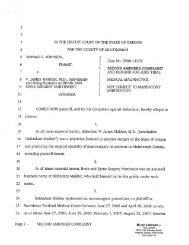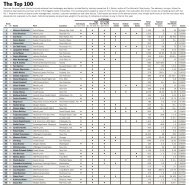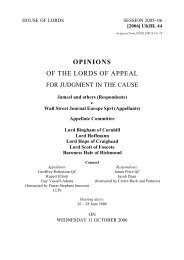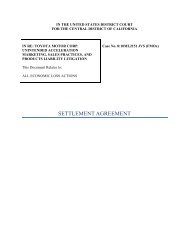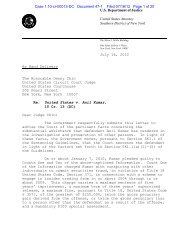Salz Review - Wall Street Journal
Salz Review - Wall Street Journal
Salz Review - Wall Street Journal
You also want an ePaper? Increase the reach of your titles
YUMPU automatically turns print PDFs into web optimized ePapers that Google loves.
199<br />
<strong>Salz</strong> <strong>Review</strong><br />
An Independent <strong>Review</strong> of Barclays’ Business Practices<br />
Not all high-risk industries have zero tolerance for safety risk. Wildfire fighters, for<br />
example, must balance allowing wildfires for environmental renewal, while protecting<br />
human life and property. To achieve this balance, wildfire fighters first reduce unnecessary<br />
risks, by actively pre-empting wildfires through controlled burn offs. Continual risk<br />
evaluation process improvement is supported by feedback from fire analysts, training based<br />
on an historical experience base, and on-call experts. Finally, the industry culture empowers<br />
staff on site to make decisions, given their situational awareness.<br />
Other high-risk industries must manage competing objectives and stakeholders’<br />
expectations. In the pharmaceutical manufacturing industry, the dominant concern is<br />
patient safety. Pharmaceutical companies must ensure product safety, observe extensive<br />
legal and regulatory requirements and manage the significant costs of research and<br />
development, but they must also foster invention and innovation. Stakeholders (employees,<br />
trial participants, patients, physicians, carers, regulators and the public) all have interests in<br />
ensuring the risks and business practices of the pharmaceutical industry are closely<br />
managed. Pharmaceutical companies manage risk by partnering closely with regulators (to<br />
ensure safety and obtain approvals) and closely controlling standardised manufacturing<br />
processes. They also foster a culture of fact-based decision-making, informed by sequential<br />
trials, and clear risk/benefit evaluations.<br />
In some high-risk industries, striking a clear balance is hard. Defence contractors 307 have<br />
many, sometimes competing objectives. These include: national security; maintaining a<br />
national defence capacity; commercial profit and economic benefit. The industry also seeks<br />
to manage a balance between private and public interest – with the ability of a country to<br />
defend itself cost effectively partly depending upon the contractor achieving significant<br />
exports. Defence contractors must also weigh the ethical, reputational, bribery, corruption,<br />
legal, commercial, confidentiality, political, and “through-life” risks of each contract. To<br />
manage the combination of risk and competing objectives, defence contractors put in place<br />
robust policies and procedures which are reinforced by regular internal and external audits.<br />
This helps ensure strict compliance with controls and identification of issues.<br />
Companies need to consider not only physical or financial risks, but also reputational risks.<br />
In the automobile industry there have been periodic safety concerns. For example, the<br />
Ford Pinto was a popular subcompact car sold between 1971 and 1980. In 1977, a<br />
magazine article 308 claimed the Pinto’s structural design was dangerous for passengers. It<br />
cited a 1973 Ford internal cost-benefit analysis, which concluded that it would be cheaper<br />
to pay off lawsuits resulting from damage and injuries than to recall vehicles for repair. The<br />
article surmised that Ford had been aware of the Pinto security issues for a few years, but<br />
had decided not to act upon them. The memorandum quickly became known as the ‘Ford<br />
Pinto Memo’ and caused huge damage to Ford’s reputation. However, Ford’s senior<br />
management claimed that the memo’s figures applied to the US car manufacturing industry<br />
as a whole, and that the memo was primarily used to petition the National Highway Traffic<br />
Safety Administration (NHTSA) to enhance road safety, by reconsidering low expected<br />
penalties from car accident lawsuits. Following the “Ford Pinto Memo” controversy, the<br />
NHTSA ultimately directed Ford to recall the Pinto in 1978 for safety failures. Nowadays,<br />
307 See the report by The Rt Hon The Lord Woolf of Barnes and the Woolf Committee, “Business ethics,<br />
global companies and the defence industry – Ethical business conduct in BAE Systems PLC – the way<br />
forward”, May 2008; http://ir.baesystems.com/investors/.<br />
308 Mark Dowie, Pinto Madness, Mother Jones, September/October 1977 issue.




